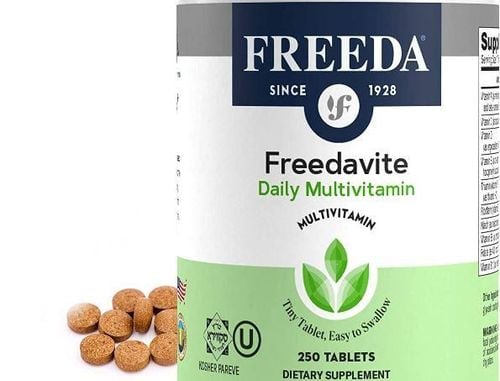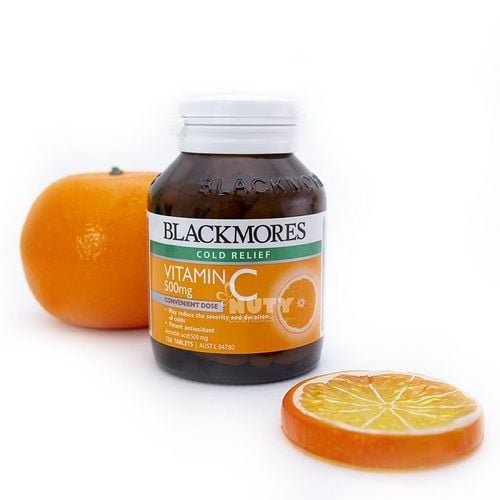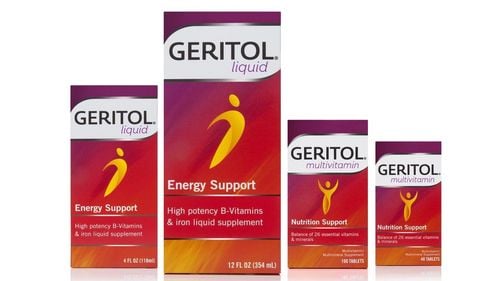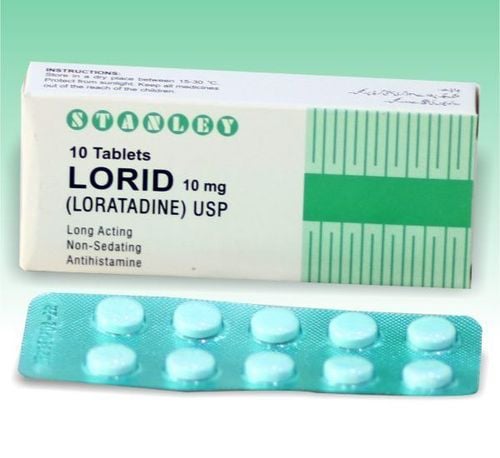This is an automatically translated article.
Ribomin medicine is packaged in 2g packages, each box has 30 packs with the main ingredients being vitamins A, B1. B2, B5, B6, B12, C, D3, E, vitamin PP... So what effect does Ribomin have?
1. What is Ribomin?
Each ingredient in the drug Ribomin 2g has other uses as follows:
Vitamin A: 2000-IU (necessary for vision, growth, development and maintenance of the epithelium); Vitamin B1 - Thiamin: 1.2mg (coenzyme that metabolizes carbohydrates); Vitamin B2 - Riboflavin: 1.2mg (converted into 2 active coenzymes necessary for tissue respiration, thereby helping to activate pyridoxine, converting tryptophan to niacin and involved in erythrocyte integrity, essential for the system electron transport system in the body); Vitamin B3 - Niacinamide: 12.0-mg (as a coenzyme to transport hydrogen to catalyze oxidation - reduction reactions needed for cellular respiration, glycogenolysis, lipid metabolism); Vitamin B5 - Calcium D-pantothenate: 5.0mg (is a precursor of coenzyme A required for acetylation reactions in gluconeogenesis, energy release from carbohydrates, fatty acid synthesis and degradation, sterol synthesis and steroid hormones, porphyrins, acetylcholine and others); Vitamin B6 - Pyridoxine Hydrochloride: 1.4mg (acts as coenzymes in protein, glucid and lipid metabolism, participates in the synthesis of gamma-aminobutyric acid (GABA) in the central nervous system and participates in the synthesis of hemoglobin); Vitamin B12: 0.032mg (essential for cell replication and growth); Vitamin D3: 400IU (maintains normal plasma calcium and phosphorus concentrations); Vitamin E: 8mg (antioxidant); Vitamin C: 70mg (necessary for collagen formation, tissue regeneration in the body and participation in some oxidation - reduction reactions).
2. When is Ribomin 2g indicated?
Ribomin 2g medicine is used to supplement vitamins necessary for the body in the growing age of children, or to supplement and prevent vitamin deficiency when the diet does not provide adequate nutrients. Ribomin 2g is also very good for patients in the recovery phase after illness. It is very helpful to take vitamin supplements during the period when the body needs more vitamins, especially at the time of changing seasons.
3. Dosage of Ribomin 2g
Dissolve the package of Ribomin 2g in 30 ml of warm water that has been boiled before, take with food or as prescribed by the doctor depending on the case. Dosage of Ribomin 2g:
Newborns: Take Ribomin 2g from 1/2 - 1 pack/day; Children and adults: Use Ribomin 2g at a dose of 1-2 packs/day.
4. Is it okay to overdose on Ribomin 2g?
High dose and prolonged use of Ribomin 2g can lead to an overdose of vitamins with characteristic symptoms as follows:
4.1. Vitamin A overdose in Ribomin 2g Chronic vitamin A poisoning: fatigue, excitability, loss of appetite, weight loss, vomiting, digestive disorders, fever, liver - spleen enlargement, hair loss, dry brittle hair , chapped and bleeding lips, anemia, headache, high blood calcium, edema under the skin, pain in bones and joints.
In children, symptoms of chronic poisoning also include increased pressure in the skull (stretch fontanel), papilledema, tinnitus, visual disturbances, and painful swelling along the long bones. When vitamin A is stopped, the symptoms of overdose also disappear, but bone growth may stop because the ends of the long bones have been ossified too soon.
Acute poisoning with vitamin A: patients are sleepy, dizzy, nausea, vomiting, excitation, headache, delirium, convulsions, diarrhea ... Symptoms appear after taking Ribomin 2g with dose very high vitamin A from 6-24 hours. Stop taking Ribomin 2g and carry out symptomatic and supportive treatment.
4.2. Niacinamide (Vitamin B3) Overdose There is no specific antidote for B3 overdose, only conventional measures such as induction of vomiting, gastric lavage, symptomatic treatment are used.
4.3. Overdosage of Pyridoxine Hydrochloride (vitamin B6) Pyridoxine (vitamin B6) is not toxic, but when used in high doses (eg > 2 g/day or > 30 days) can cause neurosensory syndromes, ataxia, loss of coordination, and loss of coordination. sense of position, tremor of the tips, loss of coordination of sensory movements.
Stop taking Ribomin 2g for neurological dysfunction and long-term monitoring shows good recovery, it can be stopped for up to 6 months for the sensory nervous system to return to normal.
4.4. Cholecalciferol (vitamin D3) overdose Early symptoms of hypercalcemia: muscle weakness, fatigue, somnolence, headache, loss of appetite, dry mouth, metallic taste, nausea, abdominal pain, constipation, dizziness , tinnitus, loss of coordination, rash, decreased muscle tone, muscle pain, bone, kidney calcification, kidney stones, body damage (polyuria, nocturia, heavy drinking, decreased urine concentration).
Blood calcium levels should be regularly measured and serum calcium should be maintained at 9 – 10 mg/dl, not exceeding 11 mg/dl. If necessary, administer corticosteroids or diuretics to rapidly eliminate calcium, such as furosemide and ethacrynic acid.
5. Side effects of Ribomin 2g
Side effects and adverse effects will appear when taking Ribomin 2g so that the vitamin A dose is high, long-term or when taking a very high dose of vitamin A.
5.1. Side effects of Thiamin hydrochloride (Vitamin B1) Adverse reactions in the form of allergic reactions, occur mainly when injected with signs: body sweating, anaphylaxis, acute hypertension, skin rash, itching. , urticaria, dyspnea, other reactions irritation at the injection site.
5.2. Side effects of Riboflavin (Vitamin B2) Urine will turn pale yellow.
5.3. Side effects of Niacinamide (Vitamin B3) Low doses of niacinamide are usually not toxic, however, if taken in high doses, some of the following effects may occur (which go away after stopping the drug): nausea, progressive stomach ulcers , vomiting, anorexia, fasting pain, flatulence, diarrhea, dry skin, hyperpigmentation, jaundice, rash, liver failure, decreased glucose tolerance, sebaceous gland hypersecretion, aggravation of gout, increased blood glucose, hyperuricemia, headache, blurred vision, dry eyes, swollen eyelids, dizziness, heart palpitations, fainting, wheezing...
5.4. Side effects of Calcium D-pantothenate (vitamin B5) Pantothenate are not usually toxic.
5.5. Side effects of Pyridoxine hydrochloride (Vitamin B6) Pyridoxine is usually non-toxic. Prolonged use of pyridoxine at doses of 10 mg/day is considered safe, but long-term use at doses ≥ 200 mg/day may cause neuropathy.
5.6. Side effects of Cyanocobalamin (Vitamin B12) Systemic: anaphylactic reaction, fever, headache, dizziness, urticaria, erythema, pruritus, pain, nausea, secondary arrhythmia.
5.7. Side effects of Ascorbic Acid (Vitamin C) Side effects of vitamin C in overdose: increased oxaluria, hemolytic anemia, flushing, heart failure, dizziness, headache, fatigue, nausea, heartburn , abdominal pain, flank pain...
Treatment instructions: Do not suddenly stop taking Ribomin 2g after using high doses of vitamin C for a long time to prevent rebound scurvy.
5.8. Side effects of Cholecalciferol (Vitamin D3) Taking vitamin D in doses that do not exceed physiological needs is usually not toxic.
5.9. Side effects of Alpha tocopheryl (Vitamin E) Vitamin E is generally well tolerated, side effects only occur with high doses, prolonged, intravenous administration, especially when used for premature babies, low birth weight at birth. Newborn.
6. Contraindications of Ribomin 2g
Ribomin 2g is contraindicated in the following cases:
Hypersensitivity to any component of Ribomin 2g;
Malignant tumor; Severe liver disease; Gastric ulcers; Arterial hemorrhage; Severe hypotension. Allergic conditions (asthma, eczema).
7. Be careful when using Ribomin 2g
Need to be very careful when taking Ribomin 2g in case of taking high doses of vitamin A or isotretinoin. When using high doses of Niacinamide in the following cases: history of peptic ulcer, gallbladder disease, history of jaundice or liver disease, gout, gouty arthritis, diabetes mellitus. Increased sarcoidosis, hypoparathyroidism may increase sensitivity to vitamin D. Ribomin 2g does not affect the ability to drive or use machines. High doses of vitamin A should be avoided in pregnant women because high doses of vitamin A (10 000 IU/day) are potentially teratogenic. Safety has not been determined, so only use Ribomin 2g in pregnant women when it is absolutely necessary. Vitamin A is excreted in breast milk. Therefore, when breastfeeding, mothers need to take daily doses of 4000-4330. However, the safety of IU Vitamin A has not been determined. Ribomin 2g should only be used in lactating women when absolutely necessary.
8. Drug interactions of Ribomin 2g
Neomycin, Cholestyramine, Liquid Paraffin: reduce vitamin A absorption; Isotretinoin: Concomitant use of vitamin A and isotretinoin leads to vitamin A overdose; Orlistat: reduce vitamin A absorption, interfere with vitamin E absorption; Warfarin: High doses of vitamin A will increase the effect of hypoprothrombinemia; Neuromuscular Blockers: Thiamine may enhance the effect of neuromuscular blocking agents; Levodopa: Pyridoxine reduces the effect of levodopa in the treatment of Parkinson's disease; Hydralazine, isoniazid, penicilamine: increased need for pyridoxine; Colchicine, aminosalicylic acid, neomycin, histamine H-receptor antagonists: may reduce the absorption of cyanocobalamin through the gastrointestinal tract. Chloramphenicol: reduces the effectiveness of cyanocobalamin in the treatment of anemia; Omeprazol: Reduces gastric juice, reduces absorption of oral vitamin B12; Probenecid: reduced absorption of riboflavin in the stomach and intestines. Cholestyramine, colestipol: Reduces absorption of vitamins A, D3, E; Corticosteroids: interfere with the effect of vitamin D; Vitamin E reduces the effectiveness of vitamin K, increases the effectiveness of anticoagulants.
Please dial HOTLINE for more information or register for an appointment HERE. Download MyVinmec app to make appointments faster and to manage your bookings easily.













